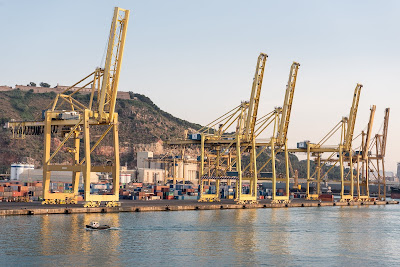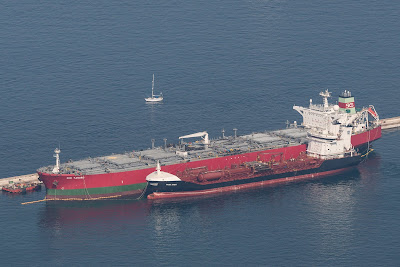During my recent European cruise, I made a point of paying attention to the other ships during our port visits. I've never spent much time in ports, and I wanted to see how these large vessels maneuver, and I wanted to see how ports operate.
One of the first things I noticed was just how much smoke the ships all seem to be belching into the atmosphere at all times. Even tied up at a dock or riding at anchor, they smoke. I presume they're running generators instead of relying on shore power. They also continuously pump bilge water overboard.
 |
| Smoky Ferry |
We boarded the cruise ship (Crown Princess) in Piraeus, and there was a lot of ferry activity. Several large ships came and went as we waited for our own departure. Here in the US there aren't a lot of ocean-going ferries. Most of this kind of activity is for service to islands near New England and the Canadian coast, or along the Pacific Northwest. But it makes perfect sense that there are many ferries around the Mediterranean.
 |
| Piraeus with the Acropolis in the Distance |
Our first port call was Santorini. There's no cruise ship dock, so we used tenders to get ashore. A small flotilla was busy all day.
 |
| Crown Princess at Santorini |
There were a few other cruise ships there during the same day.
 |
| Cruise Ship at Santorini |
 |
| Cruise Ship at Santorini |
I spent a lot of time looking at other ships, checking out the various features. I'm amazed at how many people fit in those lifeboats. We also tendered in Kotor, but docked at all other ports. The crew of our ship launched boats even when we were docked. They used the boats to service/maintain the ship and once there was even a man overboard drill with several boats launched.
 |
| Tender/Lifeboat |
I also had the opportunity to observe several pilots coming aboard or getting off. The pilot boats mostly look the same. They're small, with powerful engines, and lots of handholds.
 |
| Pilot Boat |
During arrivals, the pilots met us out of the harbor by coming alongside and then stepping off the pilot boat and onto the ship through a door in our ship that was located near the waterline. Reverse the process for the departures. The pilot boat would stay alongside as we exited the harbor; the boat would come alongside to take the pilot off. Often these trips were VERY short, with the pilot working for less than a mile.
 |
| Pilot Boat about to come Alongside to Take the Pilot Off |
During one such exchange, I happened to be atop the bridge, so I was able to actually watch the pilot coming aboard.
 |
| Coming Aboard |
Most of the time the pilots didn't even wear life vests. You would think they were going out to the store, or some casual lunch given the way they were dressed. This one was dressed more professionally than most.
Sometimes I saw lines stretched like this, and I wondered how they managed to get those lines stretched so far from the ship. The answer: a small motorboat would come alongside and grab the lines and take them out to the mooring.
 |
| Lines Stretched Out |
I watched this ferry arrive in port. It came in bow first, used thrusters to pirouette, dropped anchor well away from the wharf, then reversed until the stern was close to the wharf, playing more anchor chain out as it went. Then a motorboat came along, grabbed the lines that were played out from the huge winches, and towed the lines to shore, where workers grabbed them and dropped them on the bollards. Then the deck hands used the winches to take the slack up in the lines, drawing the ship closer to the wharf. Then they pulled the anchor chain tight, and finally dropped the ramp to allow vehicles off/on. That was quite a lot of work to get tied up. But the benefit of all this work is that the ship is already in position for an easy departure: pull the lines in, pull the anchor up, and forward thrust.
 |
| An Ugly Ferry with its Stern Backed Up to the Wharf |
Naples is a container port. There were lots of cranes, with Vesuvius looming not far away. The light was awful so this photo kind of sucks. I'm showing it anyway because there are so many cranes and hauled-out boats, and of course, the famous volcano. It also shows the balcony rail for my cabin and the extended bridge. Passengers were allowed on top of the bridge when the weather was good.
 |
| Port of Naples and Vesuvius |
Naples was the only place I remember seeing tugboats. Most ships seem to have thrusters these days. No need for tugboats to help them maneuver.
 |
| A Rare Tugboat |
Barcelona was by far the most interesting port. There were tankers, container ships, and cruise ships coming and going. We were tied up directly across from a ship that was actively discharging containers.
 |
| Discharging Cargo |
There was a Costa cruise ship tied up astern from us. That profile looks so familiar; the Concordia looked just like this because they are the same class.
 |
| Costa Fascinosa in Barcelona |
 |
| Container Cranes in Barcelona |
In just about every port, I saw baby tankers. They would pull alongside large ships and tie up. They stayed for several hours at a time, pumping fuel to the larger ship.
 |
| Oiler |
Here's a natural gas tanker.
 |
| Tanker in the Bay of Gibraltar |
I got to see quite the variety of ships and maneuvers. It's amazing how well these large ships can maneuver in the small harbors. Our own ship was huge, but surprisingly graceful. Only rarely did I sense any rolling motions, and I never saw any pitching action.
As for life aboard ship as a passenger, it was comfortable. There was too much to eat, and there was always noise. Days at sea were kind of boring, but relaxing. The pools were always packed, but that's OK, I'm not a pool person. I spent a lot of time reading, napping, and walking the promenade deck.
 |
| Promenade Deck with Lifeboats Hanging Above |
The dining room vibrated a lot. Evening meals were above some machinery that made a rhythmic boom. The first day aboard, the air conditioning wasn't working on our deck. It seems the ship mostly works OK, but it's showing lots of signs of wear.
 |
| Typical Corridor Aboard |
Breakfast and lunch were in the food court, where there was a buffet. The food was good. The carpets and tables and chairs were worn. One table had a persistent drip from something in the ceiling. It never rained during the cruise; the water must have come from a pipe or overhead machinery.
 |
| Food Court |
Most of the cabins that had balconies had some overhead cover. But not the balconies on my deck: deck 9, aka the Dolphin deck. There was no overhead cover at all. Passengers above could easily see my balcony. And when the sun was on that side of the ship, the balcony was hot and unusable. I wouldn't book a cabin on that deck again.
 |
| No Overhead Cover on the Lowest Balconies |
Days in port were hectic. We usually docked early in the day, and we would make sure we were among the first off the ship. The cities were crowded and hot. We saw a lot of sights, and usually returned to the ship early in the day to beat the heat and to relax without worrying about being late for the next departure.
In summary, I'd say that it was a mix of go-go-go and relax-relax-relax. I had a lot of fun, but I'm glad to be back home.






















No comments:
Post a Comment